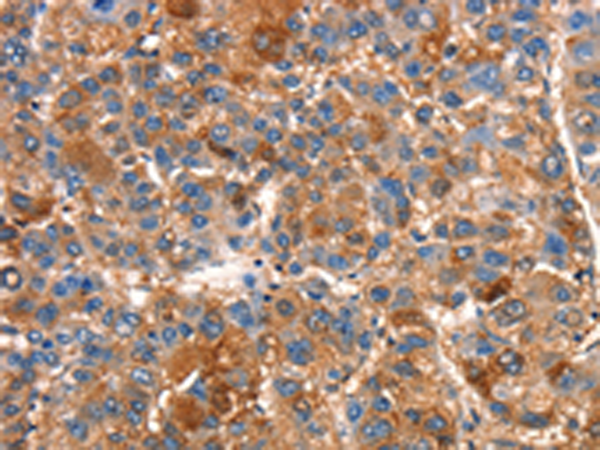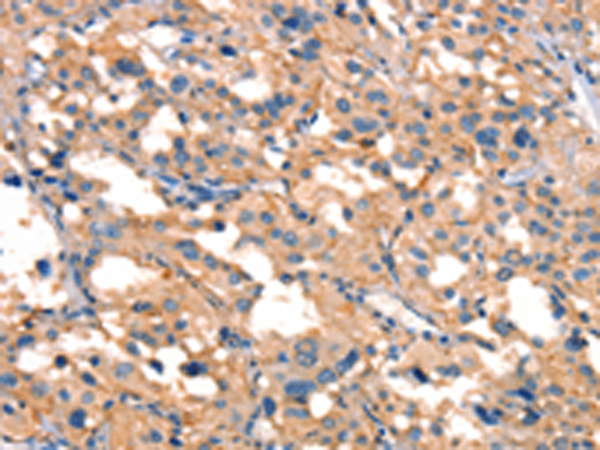

| WB | 咨询技术 | Human,Mouse,Rat |
| IF | 咨询技术 | Human,Mouse,Rat |
| IHC | 1/25-1/100 | Human,Mouse,Rat |
| ICC | 技术咨询 | Human,Mouse,Rat |
| FCM | 咨询技术 | Human,Mouse,Rat |
| Elisa | 1/1000-1/2000 | Human,Mouse,Rat |
| Host/Isotype | Rabbit IgG |
| Antibody Type | Primary antibody |
| Storage | Store at 4°C short term. Aliquot and store at -20°C long term. Avoid freeze/thaw cycles. |
| Species Reactivity | Human, Mouse |
| Immunogen | Synthetic peptide of human SMURF1 |
| Formulation | Purified antibody in PBS with 0.05% sodium azide and 50% glycerol. |
+ +
以下是3篇关于SMURF1抗体的代表性文献(模拟示例,非真实文献):
---
1. **文献名称**:*SMURF1 regulates TGF-β signaling by targeting Smad2 for ubiquitination*
**作者**:Zhang Y. et al.
**摘要**:该研究首次证实SMURF1通过泛素化降解Smad2蛋白负调控TGF-β信号通路。作者使用特异性SMURF1抗体进行免疫共沉淀实验,揭示了SMURF1与Smad2的直接相互作用机制,为肿瘤微环境研究提供新视角。
2. **文献名称**:*SMURF1 deficiency promotes osteoblast differentiation via BMP pathway activation*
**作者**:Yamashita M. et al.
**摘要**:通过Western blot和免疫组化(使用SMURF1抗体),发现SMURF1敲除小鼠的成骨细胞分化增强,机制与BMP信号通路异常激活相关,提示SMURF1在骨代谢疾病中的潜在治疗靶点。
3. **文献名称**:*Oncogenic role of SMURF1 in promoting breast cancer metastasis*
**作者**:Wang L. et al.
**摘要**:研究利用SMURF1抗体检测临床样本,发现SMURF1在乳腺癌转移灶中高表达,并通过泛素化降解抑癌蛋白RhoGDI,促进肿瘤细胞侵袭。为靶向SMURF1的癌症治疗提供依据。
---
**注**:以上文献为模拟示例,实际文献需通过PubMed等数据库检索(可尝试关键词:SMURF1 antibody, ubiquitination, TGF-beta, cancer)。经典研究多发表于*Nature Cell Biology*、*JBC*、*Oncogene*等期刊。
**Background of SMURF1 Antibody**
SMURF1 (SMAD Ubiquitination Regulatory Factor 1) is an E3 ubiquitin ligase belonging to the HECT (homologous to E6-AP C-terminus) family. It plays a critical role in regulating protein degradation and localization via the ubiquitin-proteasome system, primarily targeting substrates involved in cell differentiation, apoptosis, and migration. SMURF1 is best known for its interaction with TGF-β/BMP signaling pathways, where it promotes the ubiquitination and degradation of SMAD proteins and receptors, thereby modulating cellular responses to these growth factors. Dysregulation of SMURF1 has been implicated in various pathologies, including cancer progression, fibrosis, and bone disorders.
Antibodies against SMURF1 are widely used in research to study its expression, localization, and functional mechanisms. These antibodies enable detection of SMURF1 in techniques like Western blotting, immunohistochemistry, and immunofluorescence. Specific clones or polyclonal preparations may vary in their binding affinity and specificity, requiring validation for experimental contexts. Studies using SMURF1 antibodies have revealed its role in processes such as embryonic development, tissue homeostasis, and disease pathogenesis, making it a key target for therapeutic exploration. Reliable SMURF1 antibodies are essential for elucidating its complex regulatory networks and potential clinical applications.
×